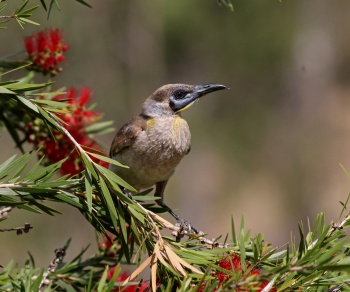- Philemon citreogularis
Identification
25–29 cms (9¾-11½ in)
Male:
- Brownish-grey above
- Paler grey on neck and collar
- A bare blue-grey face patch
- Pale greyish white below with fine white streaking on the breast.
Females are slightly smaller, but otherwise similar.
Juveniles are browner above, with yellow chin and throat
Their scientific name "citreogularis" means yellow throat but it is only the juveniles that have it.
Distribution
Australasia: found in New Guinea and Australia: New South Wales, Northern Territory, Queensland, South Australia, Victoria, Western Australia.
Taxonomy
Subspecies
There are 3 subspecies[1]:
- P. c. papuensis:
- Trans-Fly savanna of southern New Guinea
- P. c. sordidus:
- Northern Australia (Broome, Western Australia to northern Queensland)
- P. c. citreogularis:
- Eastern Australia (Cape York Peninsula to northern Victoria and southern South Australia)
Four other subspecies: occidentalis, breda, carpenteriae, johnstoni[2] are not recognised by all authorities.
Habitat
Open forests, tropical and eucalypt woodlands, near rivers; swamp-woodlands; mangroves; orchards, parks, gardens.
Behaviour
Diet
Their diet is mainly invertebrates and nectar, also flowers, fruit and seeds. They choose shady treetops to forage in.
Breeding
Both parents build the nest, a large deep open cup, which is lined with soft materials such as fine grass, always associated with water. The female alone incubates the eggs, but both parents feed the young.
Movements
In the south only as a summer breeding migrant, elsewhere somewhat nomadic.
Vocalisation
They have a variety of calls and can be rather noisy. Their calls are not well documented.
References
- Clements, J. F., T. S. Schulenberg, M. J. Iliff, S. M. Billerman, T. A. Fredericks, B. L. Sullivan, and C. L. Wood. 2019. The eBird/Clements Checklist of Birds of the World: v2019. Downloaded from http://www.birds.cornell.edu/clementschecklist/download/
- Avibase
- Handbook of the Birds of the World Alive (retrieved Sept 2018)
- Birds in Backyards
- BF Member observations
Recommended Citation
- BirdForum Opus contributors. (2025) Little Friarbird. In: BirdForum, the forum for wild birds and birding. Retrieved 9 May 2025 from https://www.birdforum.net/opus/Little_Friarbird
External Links
GSearch checked for 2020 platform.1






